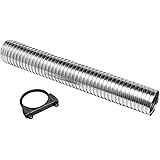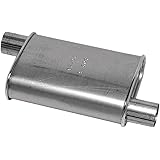Understanding Fuel Injector Latency in 8th Gen Honda Civic ===
Walker 36319 Universal Universal Exhaust Flex Pipe 1.5" Inlet (ID) 1.5" Outlet (ID)
$9.82 (as of 07/26/2024 05:24 GMT -07:00 - More infoProduct prices and availability are accurate as of the date/time indicated and are subject to change. Any price and availability information displayed on [relevant Amazon Site(s), as applicable] at the time of purchase will apply to the purchase of this product.)Walker Installer Turbo 17603 Universal Exhaust Muffler 2" Inlet (ID) 2" Outlet (ID)
$39.80 (as of 07/26/2024 05:24 GMT -07:00 - More infoProduct prices and availability are accurate as of the date/time indicated and are subject to change. Any price and availability information displayed on [relevant Amazon Site(s), as applicable] at the time of purchase will apply to the purchase of this product.)Invidia (HS00TC1GTP) N1 Cat-Back Exhaust System for Toyota Celica
$451.29 (as of 07/26/2024 05:24 GMT -07:00 - More infoProduct prices and availability are accurate as of the date/time indicated and are subject to change. Any price and availability information displayed on [relevant Amazon Site(s), as applicable] at the time of purchase will apply to the purchase of this product.)Chemical Guys CWS_402_64 Mr. Pink Foaming Car Wash Soap (Works with Foam Cannons, Foam Guns or Bucket Washes) Safe for Cars, Trucks, Motorcycles, RVs & More, 64 fl oz, Candy Scent
$24.98 (as of 07/26/2024 05:24 GMT -07:00 - More infoProduct prices and availability are accurate as of the date/time indicated and are subject to change. Any price and availability information displayed on [relevant Amazon Site(s), as applicable] at the time of purchase will apply to the purchase of this product.)NOCO Boost Plus GB40 1000A UltraSafe Car Battery Jump Starter, 12V Battery Pack, Battery Booster, Jump Box, Portable Charger and Jumper Cables for 6.0L Gasoline and 3.0L Diesel Engines, Gray
$75.28 (as of 07/26/2024 05:24 GMT -07:00 - More infoProduct prices and availability are accurate as of the date/time indicated and are subject to change. Any price and availability information displayed on [relevant Amazon Site(s), as applicable] at the time of purchase will apply to the purchase of this product.)MBRP S5200AL 3" Cat Back, Single Side Exhaust System (Aluminized Steel)
$348.74 (as of 07/26/2024 05:24 GMT -07:00 - More infoProduct prices and availability are accurate as of the date/time indicated and are subject to change. Any price and availability information displayed on [relevant Amazon Site(s), as applicable] at the time of purchase will apply to the purchase of this product.)The fuel injector latency, or the delay between the time a fuel injector is commanded to open and the actual moment it starts spraying fuel, plays a crucial role in the precise fuel delivery of an 8th generation Honda Civic. Achieving optimal fuel injector latency is vital for maximizing engine performance, fuel efficiency, and emissions control. In this article, we will delve into the process of optimizing fuel injector latency specifically for the 8th gen Honda Civic, exploring its importance, step-by-step guide, factors affecting latency, tips and tricks for fine-tuning, and common issues with solutions.
=== Importance of Optimizing Fuel Injector Latency for Honda Civics ===
Optimizing fuel injector latency is of utmost importance for Honda Civics, especially the 8th generation, as it directly impacts the engine’s fuel delivery accuracy. Precise fuel delivery is essential for ensuring efficient combustion and power production, as well as minimizing fuel consumption and emissions. By optimizing the fuel injector latency, you can enhance throttle response, reduce fuel wastage, and contribute to a cleaner environment.
=== Step-by-Step Guide to Achieving Precise Fuel Delivery in 8th Gen Civic ===
To achieve precise fuel delivery in an 8th generation Honda Civic, it is necessary to optimize the fuel injector latency. This can be done through a step-by-step process:
-
Gather relevant information: Begin by collecting the necessary data about your specific 8th gen Civic model, including engine specifications, fuel injector characteristics, and any modifications or customizations.
-
Identify the baseline latency: Measure and record the current fuel injector latency to establish a baseline. This can be done using specialized diagnostic tools or by consulting the vehicle’s technical documentation.
-
Calculate the desired latency: Determine the ideal fuel injector latency based on factors such as engine displacement, air-fuel ratio targets, and power output goals. This can be achieved through mathematical calculations or by referring to tuning resources specific to the 8th gen Civic.
-
Modify fuel injection control parameters: Access the engine control unit (ECU) and adjust the fuel injection control parameters, such as duration and offset, to achieve the desired latency. This process may involve using specialized software or hardware for ECU tuning.
-
Test and fine-tune: After making the initial adjustments, conduct thorough testing to evaluate the impact of the modified fuel injector latency. Fine-tune the parameters iteratively until the desired results are achieved.
-
Monitor and maintain: Regularly monitor the fuel injector latency and engine performance to ensure consistent and precise fuel delivery. Periodic maintenance and adjustments may be required to account for factors like component wear or changing environmental conditions.
=== Exploring the Factors Affecting Fuel Injector Latency in Honda Civics ===
Several factors influence the fuel injector latency in Honda Civics, impacting the precision of fuel delivery. These factors include:
-
Injector design: The physical characteristics of the fuel injectors, such as their size, impedance, and flow rate, can influence the latency. Different injector designs may have varying response times and spray patterns, affecting the overall fuel delivery accuracy.
-
Fuel pressure: The fuel pressure within the fuel rail can affect the latency by influencing how quickly the injector opens and closes. Higher fuel pressures generally result in shorter latency.
-
Fuel temperature: The temperature of the fuel can affect its viscosity and density, which in turn affects the latency. Cold fuel tends to be denser, leading to longer latency, while warmer fuel has lower viscosity and shorter latency.
-
Engine load and speed: The operating conditions of the engine, specifically the load and speed, can influence fuel injector latency. Higher loads and speeds may require shorter latency to maintain optimal combustion efficiency.
-
ECU programming: The engine control unit programming, including the fuel injection maps and timing, can significantly impact the fuel injector latency. Proper tuning and calibration of the ECU are crucial for achieving precise fuel delivery.
=== Tips and Tricks for Fine-Tuning Fuel Injector Latency in Honda Civics ===
When fine-tuning the fuel injector latency in a Honda Civic, consider the following tips and tricks:
-
Start conservative: It is advisable to begin with conservative adjustments to the fuel injector latency and gradually work towards the desired values. This approach ensures that you do not overshoot or risk damaging the engine.
-
Seek professional assistance: If you are new to tuning or feel unsure about making adjustments to the fuel injector latency, it is recommended to seek professional assistance from experienced tuners or mechanics who specialize in Honda Civics.
-
Conduct regular maintenance: Maintain the fuel injectors and associated components regularly to ensure optimal performance and reliability. Cleaning or replacing clogged or malfunctioning injectors can help improve latency and fuel delivery.
-
Consider aftermarket modifications: Upgrading to aftermarket fuel injectors or other performance-enhancing modifications may require adjustments to the fuel injector latency. Consult with reputable aftermarket part manufacturers or tuners for guidance.
=== Common Issues and Solutions for Fuel Injector Latency in 8th Gen Honda Civic ===
While optimizing fuel injector latency, you may encounter common issues such as uneven fuel delivery, rough idling, or decreased fuel efficiency. Some potential solutions for these issues include:
-
Clogged injectors: Use fuel injector cleaning solutions or have the injectors professionally cleaned to remove deposits and improve their performance.
-
Faulty injectors: If the injectors are faulty, it may be necessary to replace them with new or refurbished ones to ensure accurate fuel delivery.
-
ECU calibration issues: Verify that the ECU programming and fuel injection maps are properly calibrated for your specific 8th gen Civic model. Consult tuning experts or refer to reliable resources for guidance.
-
Vacuum or air leakages: Inspect the intake manifold and associated vacuum lines for any leaks that may affect fuel delivery. Repair or replace any damaged components as needed.
===
Optimizing fuel injector latency is a critical aspect of achieving precise fuel delivery in an 8th generation Honda Civic. By understanding the importance, following a step-by-step guide, considering influencing factors, implementing tips and tricks, and addressing common issues, you can enhance the performance, fuel efficiency, and overall driving experience of your Honda Civic. Whether you are a DIY enthusiast or seeking professional assistance, optimizing fuel injector latency will contribute to the longevity and enjoyment of your 8th gen Civic.





